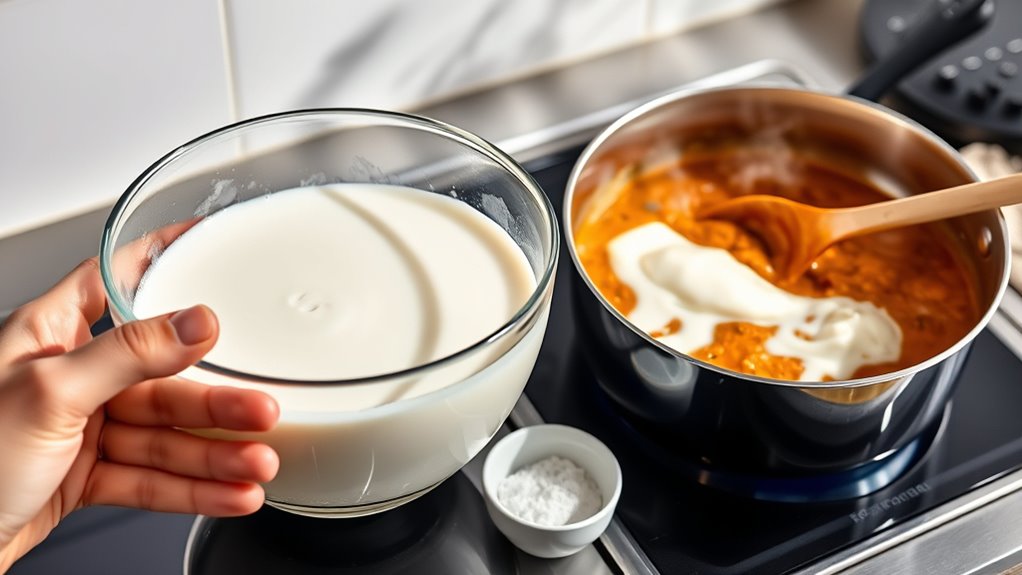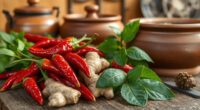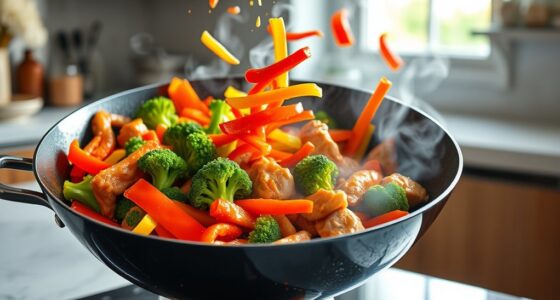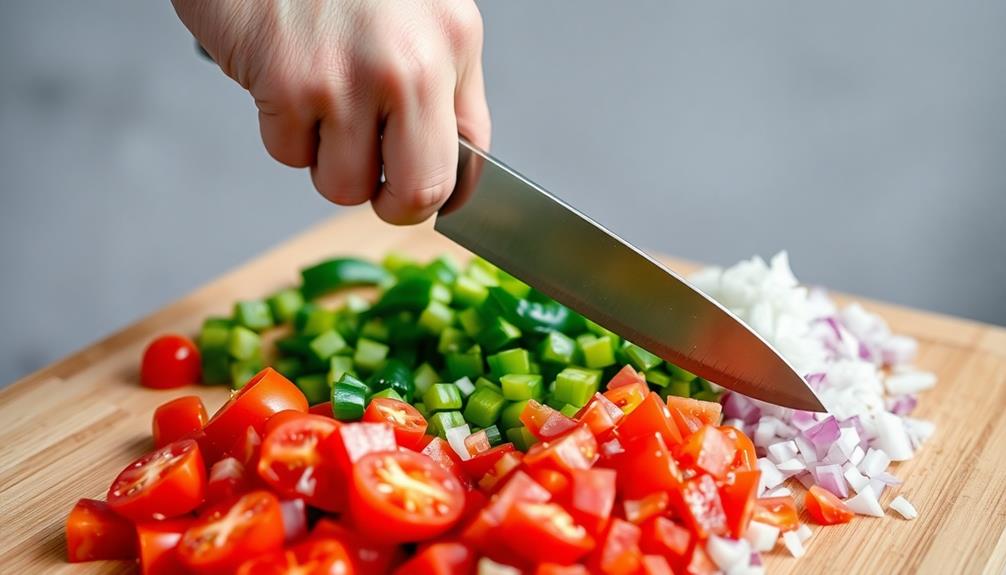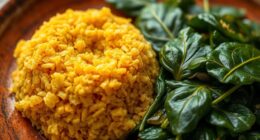To prevent coconut milk from curdling in curries, keep the heat low and avoid boiling vigorously, stirring constantly for even heat distribution. Add acidic ingredients like tomatoes or vinegar gradually and after the coconut milk has been incorporated and the heat reduced. Use full-fat coconut milk for better stability, and avoid rapid temperature changes. Cooking gently and maintaining a steady simmer helps keep the emulsion intact—continue exploring these science-backed tips for perfect results.
Key Takeaways
- Warm coconut milk gradually and add it at low heat to prevent fat separation and curdling.
- Maintain gentle simmering and stir continuously to evenly distribute heat and avoid abrupt temperature changes.
- Add acidic ingredients like tomatoes or vinegar slowly and after the coconut milk is incorporated and cooled slightly.
- Use full-fat coconut milk for better emulsion stability, and consider thickening agents if acids are added early.
- Avoid boiling vigorously; keep heat low and monitor mixture closely to prevent curdling during cooking.

Coconut milk is a popular ingredient in curries, but it often curdles when exposed to high heat or acid, ruining the dish’s texture and appearance. To prevent this, you need to pay close attention to temperature control from the start. Rapid temperature changes can cause the fats in coconut milk to separate and curdle. Keep the heat at a gentle simmer rather than a rolling boil, especially once you’ve added the coconut milk. Gradually warming it helps stabilize the mixture, allowing the fats and liquids to blend smoothly. Always add coconut milk toward the end of cooking or once the heat is low to avoid exposing it to intense heat that can trigger curdling.
Prevent coconut milk curdling by simmering gently and adding it late in cooking.
Equally important is ingredient compatibility. Not all ingredients pair well with coconut milk, especially acidic components like tomatoes or vinegar. When combining these, add them gradually and monitor how the mixture reacts. If you introduce acid too early or in large quantities, it can cause the coconut milk to curdle. To minimize this risk, consider adding acidic ingredients after the coconut milk has been incorporated and the heat has been reduced. This way, you give the fats in the coconut milk time to emulsify properly before acid disrupts the mixture.
Another key aspect is understanding how different ingredients interact with coconut milk. For example, some vegetables or spices may contain natural acids or enzymes that could affect stability. Test small batches first or adjust the timing of adding certain ingredients. Also, in some recipes, using full-fat coconut milk provides more stability than light versions because the higher fat content helps prevent curdling. If you’re working with lower-fat options, take extra care with temperature and acidity. Incorporating stabilization techniques such as adding a small amount of cornstarch or other thickening agents can further help maintain a smooth texture during cooking. Monitoring your cooking process is essential. Keep the heat low once coconut milk is added, and avoid boiling it vigorously. Stir constantly to distribute heat evenly, which helps prevent localized overheating that can cause curdling. Be mindful of how long the coconut milk is exposed to heat—prolonged simmering at high temperatures increases the risk of separation. If you notice the mixture thickening or curdling, lower the heat immediately and stir gently.
Frequently Asked Questions
Can Using Fresh Coconut Milk Prevent Curdling?
Using fresh coconut milk can help prevent curdling because it generally has a longer shelf life and fewer preservatives that might cause separation. When you choose fresh coconut milk, you’re getting a product with natural fats and proteins that blend smoothly when heated. This reduces the chance of curdling in your curry. Just make sure to use it before its expiration date and store it properly for the best results.
Does Adding Acid Affect Coconut Milk Stability?
Adding acid can disrupt the pH balance of coconut milk, which impacts its emulsification stability. When you introduce acidic ingredients, the coconut oil and water may separate, causing curdling. To keep your curry smooth, avoid adding acid too early or in large amounts. Instead, add acids carefully near the end of cooking, and consider balancing flavors with a bit of sugar or salt to maintain emulsification stability.
What Role Does Temperature Play in Curdling?
Temperature plays a vital role in curdling coconut milk. If you don’t manage heat properly, high temperatures can cause the milk to separate and curdle. To prevent this, practice temperature control by simmering your curry gently instead of boiling vigorously. Consistent heat management keeps the coconut milk stable, ensuring a smooth, creamy texture. Always add coconut milk last and avoid sudden temperature changes for the best results.
Are There Specific Spices That Cause Coconut Milk to Curdle?
Did you know some spices can cause coconut milk to curdle? Certain spice interactions, like adding acidic spices such as tamarind or citrus, can impact flavor impacts and increase curdling risk. You should add these spices carefully, preferably late in cooking, to prevent curdling. Avoid combining high-acid spices with coconut milk early on, and instead, taste as you go to maintain that smooth, creamy texture in your curry.
How Long Can Coconut Milk Be Stored Before It Curdles?
You can typically store coconut milk for about 4 to 7 days in the refrigerator before it starts to spoil. Keep an eye on spoilage indicators like sour smell, changes in color, or a lumpy texture. Proper storage in an airtight container helps extend its freshness. If it develops any off-odor or appearance, it’s best to discard it. Always check the expiration date before use to ensure quality.
Conclusion
Now that you know these science-backed tricks, your coconut milk will stay smooth and silky, like a well-choreographed dance. Think of it as wrapping your curry in a cozy, protective blanket that keeps curdling at bay. With a little care and attention, you’ll turn every dish into a creamy masterpiece that’s as inviting as a warm hug. So go ahead, cook confidently, and let your curry shine without a single curdle in sight!
